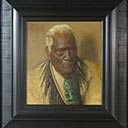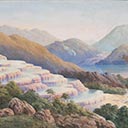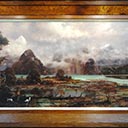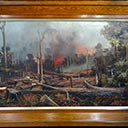A Chieftain of the Arawa Tribe Wharekauri Tahuna Aged 102, A Noble Relic of a Noble Race,
47 x 42 cm
est. $800,000 - 1,200,000
PROVENANCE
Extended Goldie family collection 1941 - 2008
Private Collection, Auckland
ILLUSTRATED
p. 291 C F Goldie His Life & Painting, Alister Taylor & Jan Glen, Waiura Marlborough, 1977
Charles Goldie's 1941 portrait of Wharekauri Tahuna is nothing short of an artistic tour de force. In executing this work, Goldie deployed the technical finesse which he had perfected over the course of an entire career to maximum effect, allowing him to powerfully express the likeness and mana of his sitter. Understood to be his final major work, this portrait heralds the closing of the final chapter in the artist's magnificent oeuvre - an oeuvre very much at the heart of our national artistic history and identity.
The present work is a sensitive and reverent rendering of Wharekauri Tahuna, comprising careful yet spirited, visible brushstrokes. It has been composed with such precision as to avoid obfuscating the finer detail of the sitter's visage, but is also expressive enough in its painted manner to enhance the effect of the work's ambient light interplay; illumination is derived from a strong singular light source coming from the left of the painting. This mastery of light and texture renders the portrait lifelike: from the resplendence of Wharekauri's pounamu to the weave of his garment and tender realism of deep-etched lines in his 102-year old face Frontwards-facing and dominating the canvas, Wharekauri's strength and mana are asserted by the work's composition: instead of situating his subject neatly within the confines of the frame, Goldie has opted to create the effect that this is but a momentary framing, wherein some fleeting aspect of his subject has been captured. The enduring impression left on the viewer is of how impressive and majestic the aged Wharekauri, whose literal and metaphorical largesse extends well beyond the confines of the frame, is
The strong visual impact of this cropped perspective is further enhanced by the 'Goldie' frame in which it is presented, a design originated by Goldie's father
Having been completed just a few years before the artist's death in 1947, the portrait epitomises all the formal qualities characteristic of the later period of Goldie's artistic production. This mature period in his work had been preceded by more than a decade of inactivity, during which time he moved to Sydney, was married and remained there for two years. Goldie's eventual resumption of painting in the early 1930s (by which time he had returned to New Zealand) saw a radical shift in his expressive technique - the crisp luminosity and inclination to academic formalism which had defined his earlier works was replaced by a much freer treatment of the painted surface.
By 1941, when the present portrait was produced, Goldie's increasingly experimental forays into a more dynamic use of oil paint had led him to fully master the subtleties of a new and eloquent visual language. This instilled his works with a deeper sense of gravitas and atmosphere, as can be encountered in this portrait of Wharekauri
Wharekauri Tahuna was a tohunga, or priest, from Galatea and of Ngāi Tūhoe. Thought to have been the last man in the Ureweras to bear full-face moko, he was one of Goldie's favoured subjects and features in a number of notable works completed by the artist throughout his career. In 1933, Goldie completed a portrait of Wharekauri, now a prized painting in the collection of Te Papa Tongarewa. An earlier portrait had been completed in 1910, as well as a splendid 1914 work now residing in the collection of Auckland War Memorial Museum. These ultimately speak to the value which Goldie invested in his relationships with sitters: in undertaking these portraits, he was engaging in much more than a perfunctory transaction or process of ethnographic documentation, by actually becoming heavily invested in longstanding relationships. Considering this 1941 portrait of Wharekauri, therefore, the viewer is compelled to appreciate not only the culmination of a lifetime of artistic production, but also to sense the intimacy of a journey spanning decades between Wharekauri and Goldie A brief meditation on the painting's titular description of Wharekauri as A Noble Relic of a Noble Race is fitting by way of conclusion. Whilst aspects of Goldie's enduring nostalgic attitude towards Maori are undeniably problematic, in this instance there exists a poetic and spiritual undercurrent: one which speaks of Goldie's struggle with his own physical decline, and echoes the fading passage of time. In this way, the final act of painting Wharekauri was an exercise in self-awareness and closure for Goldie, as he returned to paint one of his best-loved subjects towards the end of both Wharekauri's and his own life (a fact he would have been forced to deal with given his own poor health, a likely consequence of lead poisoning). With this in mind, the presentation of this exceptional portrait to the market is, to say the least, a rare and exciting occurrence





